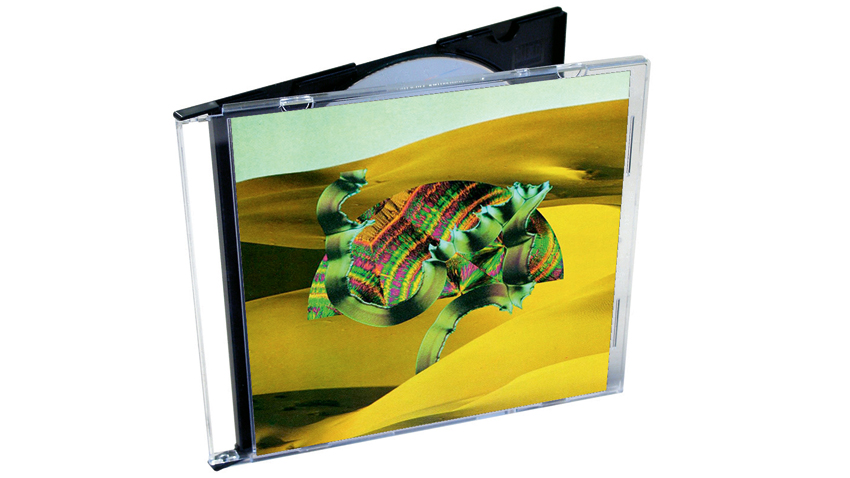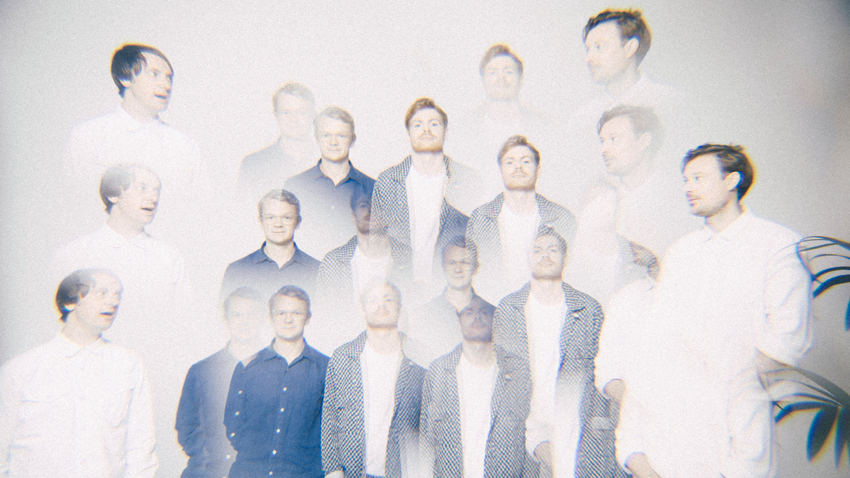Classic album: David Maclean on Django Django
Django Django’s front man takes us through the band’s thrifty eponymous 2012 debut

With their assured electro-rock swagger, and consistently incendiary live shows, you might be forgiven for thinking that Django Django knew exactly what they were doing when it came to making their eponymous debut album.
And because of the sweeping scale of their sound, and the shimmering polish of their production, you might also hazard a fair guess that it was made by a veteran of the studio, with a jaw-dropping array of vintage gear at his disposal.
“Nah,” says amiable bandleader, Davis Maclean. “I had no idea what I was doing. And it must have cost us about £80 to make that record!” Ah. So it turns out that having bugger all money is the mother of invention, then.
Maclean, along with Vinnie Neff on vocals, Jimmy Dixon on bass and Tommy Grace on his trusty Juno synth, made the best of what they had. Sometimes that was a Yellow Pages standing in for a drum kit, and sometimes it was coconuts and Lynx cans on percussion duties.
“It was so lo-fi,” says Maclean. “But I liked the limitations. I would just say, ‘The drums should sound like this’. And I would hit a phone book with the drumsticks or a deodorant can, or whatever was lying around the kitchen.
“Really, it was a case of just pushing things. I was just making it all up. Seeing what we could do with just the computer. We didn’t even have a soundcard. The mic went into the back of the computer, into the soundcard that came with the PC. And I was just using every effect module that Cubase had. Version 1, too.”
Like all the best music, it was ideas that led the charge. Maclean, a jobbing DJ by this point, with some of the weirdest and widest record crates around, drew from his immense influences on wax. All of his favourite records became jumping off points for Django Django’s music.
Get the MusicRadar Newsletter
Want all the hottest music and gear news, reviews, deals, features and more, direct to your inbox? Sign up here.
“I was big into crate digging and picking up everything from jazz, rockabilly, and psych rock, to dance music and dub. That was the backbone. We wanted the album to be about the songs, really, rather than the process.”
Here, Maclean takes us through takes us through Django Django track by track.

Introduction
“We’d all been listening to a DJ mix of rare library records by 2manyDJs [Radio Soulwax’s Librarian Girl]. That was the influence here, really.
“We went about digging out all these strange records in that style and tried to get that futuristic but old sound. I remember us listening to that mix and trying to recreate some of the atmosphere on here.
“I loved intros, anyway. I was obsessed with mixtapes and would always put an introduction on any I made. It might just be someone talking backwards, or something weird. It’s just something to make people smile and ease them in.”
Hail Bop
“This started as a sort of hip-hop beat I made from an old, slowed down disco break at the wrong speed back in the mid-90s. Vinnie just riffed a guitar line over the top as I messed with the knob on the delay.
“It only really became Hail Bop when we put the ending on it. It wasn’t really going anywhere, until we decided to give it a name and a chorus. That all happened in the last minute. I didn’t really know what a ‘song’ was, with choruses and structure. It was just a lot of winging it on that one, really [laughs].”
Default
“I wanted to make something raw. It’s only got a few elements - like the squeaky synths I did on the Jen [Synthetone SX-1000], messing with the octave button. Everything is either the Jen or guitar. The bass is all Jen. The beat is all just little samples from funk and disco breaks, chopped up.
“No one wanted it as a single when we tried shopping it around a few labels. They were like, ‘Oh. This is weird. Where’s the chorus?’ I had to fight for that to be the single. I had a gut feeling there was something catchy about it.”
Firewater
“This is a sort of campfire thing - very acoustic guitar. The beat was very simple. Just me tapping out a beat at the desk in my bedroom, then smacking it through loads of reverb, hoping for the best.
“I remember writing the lyrics for this one and it being a lot of fun. It started out as a comedy song, full of the clichés of campfire sing-a-longs and stuff like that. Then we decided to make it a bit more serious.
“It’s about getting drunk. We didn’t really worry what kind of music it was, or how it would fit in with the others. We just had fun making it.”
Waveforms
“This was a really slow folk song that Vinnie had written. Then I made this almost Afro beat type drum pattern, a bit of an accident. The drums weren’t meant to be like that, but I put them in the wrong bar on the grid that gave it this weird swing that we just kept.
“I wanted this to be very vocally, too. There’s about 12 vocal tracks on this. We ended up just flipping it on its head, though - the chorus was the verse and the verse was the chorus to start with. I just chopped it all up.”
The drums weren’t meant to be like that, but I put them in the wrong bar on the grid that gave it this weird swing that we just kept.
Zumm Zumm
“Oh god! I don’t think I’ve listened to this since I made it. We tried to play it live once - it was a catastrophe. I don’t know why it exists. It was just a loop of me playing the tambourine and a kick drum. Tommy did the riff over the top, with a loop pedal going. We had a bit of cabin fever.
“I liked it, though, and wanted to keep it on the album. The label were like, ‘Please don’t’. In hindsight, maybe we should have listened.”
Hand of Man
“That was just a little ditty that Vinnie did while waiting for something else to happen. I did the lyrics. I had this idea of going back in time and telling a caveman about where it is we’ve gone wrong. Like, what would you say to them? Don’t invent the atom bomb, or whatever.
“It’s just a daft folk song; a demo that nobody went near. Then, when we were tracking the album, we felt it was missing a moment like that. You can hear a phone in the background!”
Love's Dart
“This is me playing the drum beat on an old phone book. I put a fat delay on it. I was really into Buddy Holly and that type of production. I would just think about what they had to use. They wouldn’t have had much money. It was just about using what they had.
“One thing that always drew me into old rock ‘n’ roll, and dub records, was how you could make something simple sound fun with delays and reverbs. Vinnie came in and played the guitar. We didn’t have a bass so we pitched down the acoustic, which was something we did all the time on that album.”

WOR
“Vinnie was really into The Gun Club and rockabilly music. A lot of our early live sets were straight-up rockabilly, and this was just a hangover from those live gigs. It was the start of us putting rockabilly guitars over synths.
“It was a complicated song to write and put together because the breakdown and middle eights and choruses are weirdly juxtaposed against the guitars.
“I guess it was a bit of a Giorgio Moroder production. Like the stuff he did for Blondie, like Atomic, you know? There are also sirens at the start, like the Bomb Squad’s production for PE.”
Storm
“This is the very first song me and Vinnie did. I just turned on an old Casio keyboard, not even a CS1, and got a ‘march-style’ drum setting going, and he played the riff.
“I attempted to put the drums over it, but was just really hitting a couple of floor toms. We just laid it down, and had no idea what we were doing. We pointed the mic at the drums, plugged the guitar into the back of the computer, and off we went, really.
“The single version is a lot better than the album. The motherboard on the computer died and we lost everything and had to recreate it.”
Life’s a Beach
“That was a bit of a pain in the neck, that one, because we were playing it live and it sounded like the The Tornados or something - it had that kind of Joe Meek thing. But when we went to record it, it was kinda beyond my capabilities at the time.
“When we tried to do it as an overdub type of thing, it lost the energy and the live-ness. I wish we’d gone in the studio and done it as we were playing it live.
“But, you know, people like it… But I listen to it and just think, ‘Well…’ We definitely learnt a lot with this one.”
The single version is a lot better than the album. The motherboard on the computer died and we lost everything and had to recreate it.
Skies Over Cairo
“I was just obsessed with doing something Egyptian-sounding at the time. I don’t know why. I was trying to make some 12-bar blues, but with an Egyptian riff. I thought it would be quite fun.
“Tommy was into it. He just came up with a lot of that stuff, with me sat at the computer. I don’t know if Vinnie quite knew what to make of it.
“Our friend Cara [Tolmie] played the clarinet on there, back through a Boss delay pedal. It was another daft one like ‘Zumm Zumm’ that the label were like, ‘Don’t put this on the album. It doesn’t need it.’ We were very stubborn.
“I’ve not listened to the recorded version since we did it. In fact, they put the wrong one on the first round of pressings of the album. I was so gutted. That happens [laughs].”
Silver Rays
“We were quite influenced by [US psych act] Silver Apples and the way they played drums in a very weird way, almost like Detroit techno. Vinnie wanted to do something like that.
“Again, when I listen to it I think, ‘How did I record that so wrong?’ [Laughs]. You just learn, don’t you? I was just treating the computer like a four-track. We didn’t quantise anything. I can hear all the drum loops going out in the wrong swing.
“It was the first track we mixed for the album and it took about six attempts because there was about 150 tracks of nonsense in there. It put the engineer through the ringer. I was sat next to him the whole time. You wouldn’t do a painting and hand it to a framer and let him varnish it and put a massive gold frame on it, would you? [laughs]. You have to be in control of that, or else what’s the point, really?”


Future Music is the number one magazine for today's producers. Packed with technique and technology we'll help you make great new music. All-access artist interviews, in-depth gear reviews, essential production tutorials and much more. Every marvellous monthly edition features reliable reviews of the latest and greatest hardware and software technology and techniques, unparalleled advice, in-depth interviews, sensational free samples and so much more to improve the experience and outcome of your music-making.
"Reggae is more freeform than the blues. But more important, reggae is for everyone": Bob Marley and the Wailers' Catch a Fire, track-by-track
“Part of a beautiful American tradition”: A music theory expert explains the country roots of Beyoncé’s Texas Hold ‘Em, and why it also owes a debt to the blues










